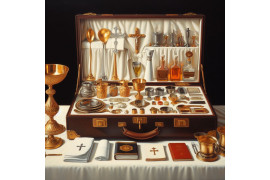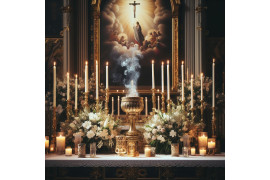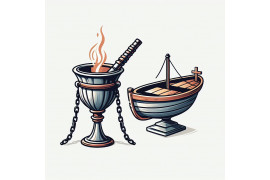The chalice holds a profound significance in the teachings of Jesus. During the Last Supper, Jesus shared the chalice with his disciples, marking the establishment of a new covenant. This act symbolized the pouring out of his blood as a sacrifice for the forgiveness of sins. The chalice represents not only the sacrificial nature of Jesus' death but also his role as the ultimate sacrifice.
In the context of the old covenant, where animal sacrifices were made to atone for sins, Jesus' words about the chalice brought forth a transformative understanding. He emphasized that through partaking in this symbolic act, his followers would be participating in his sacrifice and receiving forgiveness.
As we delve deeper into what Jesus said about the chalice, we will uncover profound insights into his mission and teachings. Join us on this journey to explore the spiritual significance and eternal implications of this sacred vessel.
Implications of Jesus' Request for the Chalice to Pass (Matthew 26:39)
Jesus, during the Last Supper, asked God if it was possible for him to avoid drinking from the chalice. This request reveals his human struggle and vulnerability. It showcases that even Jesus, being divine, experienced fear and apprehension.
This moment holds significant implications for understanding Jesus' mission and purpose. By requesting for the chalice to pass, Jesus demonstrates his acceptance of God's will. He willingly surrenders himself to fulfill the divine plan for salvation.
Acceptance of God's Will
In asking if it is possible for the chalice to pass from him, Jesus acknowledges that he is facing a difficult path ahead. This request does not signify a lack of commitment or faith; rather, it highlights his humanity. Like any human being would feel in such circumstances, Jesus experiences fear and seeks an alternative route.
However, despite his initial plea, Jesus ultimately accepts God's will. He recognizes that this suffering is necessary to accomplish his purpose on Earth – to offer himself as a sacrifice for humanity's sins.
Commitment to Fulfilling His Purpose
Jesus' willingness to drink from the chalice signifies his unwavering commitment to fulfilling his mission on Earth. He understands that by undergoing immense suffering and sacrificing himself, he can bring about forgiveness and redemption for all mankind.
This act of selflessness exemplifies Jesus' love for humanity and his desire to restore our relationship with God. It serves as a powerful reminder of the lengths he was willing to go to save us from our sins.
Endurance of Suffering
By requesting for the chalice to pass but ultimately accepting its presence in his life, Jesus teaches us about endurance through suffering. He sets an example of perseverance in times of hardship and shows us that even when faced with overwhelming challenges, we can find strength through faith.
Jesus' willingness to bear the weight of the chalice demonstrates his in-depth understanding of human suffering. He empathizes with our pain and offers us hope, knowing that through his sacrifice, we can find forgiveness and eternal life.
Contents of the Chalice and its Connection to the Eucharist (Matthew 26:27)
In Matthew 26:27, Jesus spoke about the chalice during the Last Supper, which holds significant meaning for Christians. Let's delve into what Jesus said about the chalice and its connection to the Eucharist.
The Chalice contained wine, representing Jesus' blood poured out for many
During the Last Supper, Jesus took a cup or chalice filled with wine and gave it to his disciples, saying, "Drink from it, all of you. This is my blood of the covenant, which is poured out for many for the forgiveness of sins" (Matthew 26:27-28). The wine in the chalice symbolized Jesus' blood that would be shed on the cross as a sacrifice for humanity's salvation.
Through the Eucharist, Christians partake in communion by drinking from a symbolic chalice
The Eucharist is a central sacrament in Christianity, where believers commemorate Jesus' sacrifice through bread and wine. In this act of communion, Christians drink from a symbolic chalice filled with wine or grape juice. By doing so, they participate in Christ's sacrifice and receive spiritual nourishment.
This act symbolizes believers sharing in Christ's sacrifice and receiving spiritual nourishment
Drinking from the symbolic chalice during communion signifies believers sharing in Christ's sacrificial death. It represents their acceptance of Jesus' redeeming work on the cross and their identification with Him as followers. Just as physical food nourishes our bodies, partaking in communion through the chalice provides spiritual nourishment for believers.
The act of drinking from a shared cup emphasizes unity among believers
When Christians drink from a common cup during communion services, it highlights their unity as members of one body—the body of Christ. It signifies their shared faith and fellowship with one another as they come together to remember and honor Jesus' sacrifice. This act of unity fosters a sense of community and strengthens the bond among believers.
The chalice serves as a reminder of Jesus' love, sacrifice, and the promise of eternal life
As Christians drink from the chalice during communion, it serves as a powerful reminder of Jesus' love for humanity. It represents His selfless sacrifice on the cross and the forgiveness of sins that comes through His shed blood. Moreover, it points to the promise of eternal life that believers have through their faith in Him.
Exploring Notable Chalices: Valencia, Genoa, and Doña Urraca
In the realm of sacred artifacts, chalices hold a special place of reverence. These vessels are often associated with significant religious events or figures. Let's delve into three notable chalices: The Holy Chalice of Valencia, the Genoa Chalice, and Doña Urraca's Chalice.
The Holy Chalice of Valencia
One of the most renowned chalices is the Holy Chalice of Valencia. According to tradition, this chalice is believed to be the very cup used by Jesus during the Last Supper. Its historical and spiritual significance has captured the imagination of believers for centuries.
-
Key Point: Some individuals fervently believe that this chalice holds immense spiritual power due to its connection with Jesus Christ.
The Holy Chalice is housed in Valencia Cathedral in Spain and has become an object of pilgrimage for many Christians seeking a deeper connection with their faith. Its simple design and ancient origins add to its allure.
-
Example: Pilgrims from around the world visit Valencia Cathedral to catch a glimpse of this revered artifact.
-
Key Information: The chalice consists of two parts—the cup itself, made from agate stone, and a base added later on.
-
Historical Significance: It is said that Saint Peter brought this precious relic from Jerusalem to Rome before it eventually found its way to Spain.
The Genoa Chalice
Moving on from Spain to Italy, we encounter another remarkable chalice—the Genoa Chalice. This ornate silver-gilt vessel dates back to medieval times and showcases exquisite craftsmanship.
-
Example: Located in Genoa Cathedral, this stunning chalice captivates visitors with its intricate engravings and gemstone embellishments.
-
Key Information: The Genoa Chalice stands as a testament to the skill and artistry prevalent during its creation.
While the exact origins of the Genoa Chalice remain unknown, it serves as a symbol of religious devotion and artistic excellence. Its presence within the cathedral is a testament to its enduring significance.
Doña Urraca's Chalice
Our exploration of notable chalices takes us to Spain once again, this time to encounter Doña Urraca's Chalice. This relic holds historical importance due to its association with Queen Urraca of León-Castile, who reigned in the 11th century.
-
Key Information: Doña Urraca's Chalice is an example of a chalice that has been linked to a specific historical figure.
-
Historical Significance: Queen Urraca was known for her strong leadership and political prowess during a tumultuous era in Spanish history.
The chalice itself is made of gold and features intricate designs and engravings. It serves as a tangible connection to an influential monarch from centuries past.
Unveiling Medieval Relics and Traditions Surrounding the Chalice
Medieval Christian traditions were deeply rooted in the veneration of relics associated with biblical events, such as the Last Supper. One significant relic that held great importance during this time was the chalice. Churches across Europe proudly displayed elaborate chalices as symbols of their faith and devotion.
The chalice, often referred to as the Holy Grail, became a focal point for believers who attributed miraculous powers to certain relics. According to legend, it was the cup used by Jesus during the Last Supper to serve wine to his disciples. This belief sparked a wave of fascination and reverence for the chalice among medieval Christians.
Chalices were typically made from precious materials such as gold or silver, adorned with intricate designs and gemstones. These ornate vessels served not only as functional objects for holding wine during religious ceremonies, but also as sacred artifacts believed to embody the presence of Christ himself.
The veneration of the chalice extended beyond its use in churches. It became an object of pilgrimage and a sought-after treasure for those on a quest to uncover its mysteries. The legends surrounding the Holy Grail inspired countless tales of knights embarking on epic quests r this elusive artifact.
One notable chalice associated with these legends is the Sacro Catino, also known as "the dish of Antioch." According to medieval tradition, this emerald green dish was believed to be made from emerald or even jade and was thought to have been used by Jesus at his final Passover meal before his crucifixion. Its alleged connection to Jesus' last moments on Earth added an air of mystique and reverence around it.
While there is no direct mention in historical accounts about what Jesus specifically said about the chalice during biblical events, its significance lies in its association with pivotal moments like the Last Supper. The act of sharing bread and wine during the Last Supper has been interpreted as a sacred ritual, symbolizing Jesus' body and blood.
The chalice continues to hold a prominent place in Christian worship today. It serves as a reminder of Jesus' sacrifice and the importance of communion within the faith. Churches around the world still use chalices during religious ceremonies, keeping alive the traditions that originated in medieval times.
The Chief Priest's Questioning and the Chalice: Seeking Answers from Jesus
In the midst of Jesus' arrest, the chief priest posed a question to him regarding his disciples' use of swords. Although the chalice is not directly mentioned in this interaction, it is important to understand the context in which this questioning took place.
Jesus responded to the chief priest by highlighting his teachings that were conducted openly in public places. He emphasized that he had not been hiding anything from the authorities. This response demonstrates Jesus' commitment to transparency and his willingness to share his message with all who would listen.
While this exchange does not specifically address what Jesus said about the chalice, it provides insight into his character and approach to teaching. Jesus consistently prioritized spreading his message of love, forgiveness, and salvation throughout his ministry.
Throughout the Old Testament and Hebrew scriptures, there are references to suffering and sacrifice. These themes play a significant role in understanding Jesus' teachings about the chalice. In Luke 22:42-44, during the Last Supper, Jesus prays to God, referring to him as "Father" and expressing his desire for God's will to be done. This moment signifies Jesus' acceptance of his impending suffering and crucifixion.
The chalice itself holds deep symbolism within Christian tradition. It is often associated with the cup used by Jesus during the Last Supper, when he instituted the sacrament of Communion or Eucharist. The chalice represents both Christ's sacrifice on the cross and his ongoing presence within the lives of believers.
Jesus spoke about this significance during that final meal with his disciples when he said, "This cup is poured out for you" (Luke 22:20). His words indicate that through partaking in communion, believers can experience a profound connection with Christ's sacrificial act on their behalf.
Furthermore, in Matthew 26:39-42, we witness another moment where Jesus refers to the chalice. In the Garden of Gethsemane, he prays to God, asking if it is possible for the "cup" to be taken away from him. This metaphorical reference to the chalice represents Jesus' willingness to undergo suffering and fulfill his divine purpose.
Reflecting on Jesus' Words about the Chalice
In exploring what Jesus said about the chalice, we have delved into the profound symbolism and significance behind his words. We have seen how his request for the chalice to pass in Matthew 26:39 reveals his human vulnerability and deep anguish before his crucifixion. Furthermore, we have discovered the connection between the contents of the chalice and the sacrament of the Eucharist, highlighting its central role in Christian worship.
As we reflect on these insights, it is clear that Jesus' words about the chalice hold immense spiritual meaning. They invite us to ponder our own struggles and challenges, reminding us that even in our darkest moments, we can find strength through faith. Just as Jesus willingly embraced his fate for a greater purpose, so too, can we face our trials with courage and trust in God's plan?
So, as you continue your journey of faith, take a moment to consider what Jesus' words about the chalice mean to you personally. How can they inspire you to persevere through difficult times? How might they deepen your appreciation for the Eucharist and its significance in your spiritual life? Allow these reflections to guide you towards a more in-depth understanding of your faith and a stronger connection with God.
FAQs
What is the significance of Jesus' request for the chalice to pass?
Jesus' request for the chalice to pass signifies his human vulnerability and anguish before his crucifixion. It demonstrates that he experienced fear and apprehension just like any other person would in such circumstances. However, it also highlights his unwavering commitment to fulfilling God's will despite his personal struggles.
How does the contents of the chalice relate to the Eucharist?
The contents of the chalice represent wine during Christian communion or Eucharistic celebrations. In Christianity, believers partake in wine as a symbolic representation of Christ's bloodshed for the forgiveness of sins. The chalice serves as a vessel that holds this sacred element, connecting the physical act of drinking wine to the spiritual act of receiving Christ's sacrifice.
Are there any notable chalices associated with Jesus?
While there are no chalices directly associated with Jesus himself, there are several chalices throughout history that hold great significance in Christian tradition. Notable examples include the Valencia Chalice, believed by some to be the Holy Grail, and the Genoa Chalice, which is said to have been used during the Last Supper. Another renowned chalice is Doña Urraca's Chalice, an exquisite medieval artifact revered for its beauty and historical importance.
What relics and traditions surround the chalice?
Medieval relics and traditions surrounding the chalice vary across different cultures and regions. Some claim to possess or venerate ancient chalices believed to have connections to Jesus or significant biblical events. These relics often become objects of religious devotion and pilgrimage. Various customs and rituals have developed around the use of chalices in Christian worship, emphasizing their sanctity and role in conveying spiritual grace.
How did Jesus respond to questioning about the chalice?
When questioned by the chief priest regarding his teachings, Jesus remained steadfast in his response. He affirmed his commitment to truth and spoke openly about his purpose as a messenger from God. Though not specifically addressing questions about the chalice itself during this encounter, Jesus' unwavering conviction demonstrated his dedication to fulfilling God's plan regardless of opposition or scrutiny.



